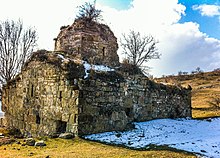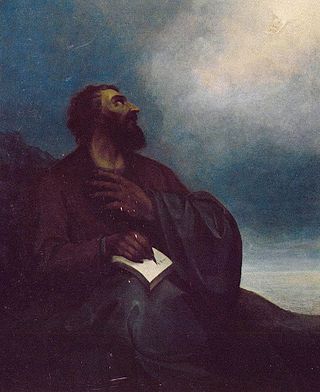
Mesrop Mashtots was an early Medieval Armenian linguist, composer, theologian, statesman, and hymnologist in the Sasanian Empire. He is venerated as a saint in the Armenian Apostolic Church, the Armenian Catholic Church, the Eastern Orthodox and Roman Catholic churches. He is best known for inventing the Armenian alphabet c. 405 AD, which was a fundamental step in strengthening Armenian national identity. He is also considered to be the creator of the Caucasian Albanian and Georgian alphabets by a number of scholars.
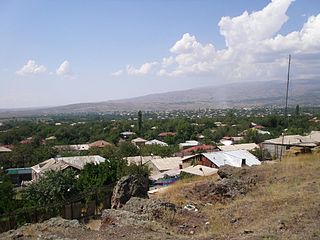
Oshakan is a village in the Ashtarak Municipality of the Aragatsotn Province of Armenia located 8 kilometers southwest from Ashtarak. It is well known to historians and pilgrims of the Armenian Apostolic Church as the site of the grave of Mesrop Mashtots, the inventor of the Armenian alphabet.

The Saint Stepanos Monastery, also known in Armenian as Maghardavank (Մաղարդավանք), is an Armenian monastery located about 15 km northwest of the city of Julfa in the province of East Azarbaijan, northwestern Iran. It is situated in a deep canyon along the Araxes, on the Iranian side of the border between Iran and Nakhchivan. It was originally built in the ninth century, and was rebuilt during the Safavid era, after being damaged through wars and earthquakes.

Noravank is a 13th-century Armenian monastery, located 122 km from Yerevan in a narrow gorge made by the Amaghu River, near the town of Yeghegnadzor in Armenia. The gorge is known for its tall, sheer, brick-red cliffs, directly across from the monastery. The monastery is best known for its two-storey Surb Astvatsatsin Church, which grants access to the second floor by way of a narrow stone-made staircase jutting out from the face of building.

Amaras Monastery is an Armenian monastery near the village of Sos, de facto in the Martuni Province of the Republic of Artsakh, de jure in the Khojavend District of Azerbaijan, in the disputed region of Nagorno-Karabakh. It was a prominent religious and educational center in medieval Armenia.

Vahanavank is a 10th-11th century Armenian monastic complex located approximately 5 kilometers west of the town of Kapan in the Syunik Province of Armenia, situated at the foot of Tigranasar mountain along the right bank of the Voghdji River.
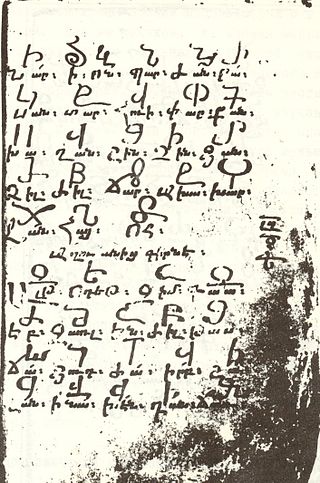
The Caucasian Albanian script was an alphabetic writing system used by the Caucasian Albanians, one of the ancient Northeast Caucasian peoples whose territory comprised parts of the present-day Republic of Azerbaijan and Dagestan.

Armenian architecture comprises architectural works with an aesthetic or historical connection to the Armenian people. It is difficult to situate this architectural style within precise geographical or chronological limits, but many of its monuments were created in the regions of historical Armenia, the Armenian Highlands. The greatest achievement of Armenian architecture is generally agreed to be its medieval churches and seventh century churches, though there are different opinions precisely in which respects.
Nəsirvaz formerly Mesropavan is a village in the Ordubad District of Nakhchivan, Azerbaijan. In the municipality of Bist village, it is located near the Ordubad-Nurgut highway, to the north-west of the district center, on the foothill. It has a population of 157.
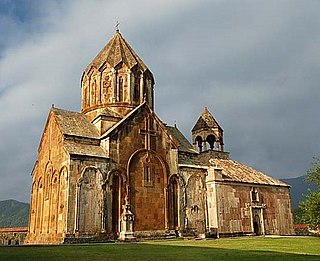
Culture of Artsakh includes artifacts of tangible and intangible culture that has been historically associated with Artsakh in the Southern Caucasus, controlled by Azerbaijan and the breakaway Republic of Artsakh. These include monuments of religious and civil architecture, memorial and defense structures, and various forms of art.

Vramshapuh was a noble of the Arsacid dynasty who served as the Sasanian client king of Armenia from 389 until his death in 414. He is mainly remembered for presiding over the creation of the Armenian alphabet by Mesrop Mashtots.

Surb Karapet Monastery of Mush was an Armenian Apostolic monastery in the historic province of Taron, about 30 km (19 mi) northwest of Mush (Muş), in present-day eastern Turkey.

Zoravor Surp Astvatsatsin Church is the oldest surviving church in Yerevan. It was previously known as Surp Astvatsatsin. However, the name Zoravor was added because the church was home to the 13th century bible of Zoravor.

Holy Mother of God Church of Bethlehem is a church in Tbilisi, Georgia. Built as an Armenian church in the 18th century, on the site of an older church, it now operates as a Georgian orthodox church.
Drazark monastery, a destroyed monastic complex of Armenian Apostolic Church in Adana province of modern Turkey, which lies about 40 km. northwest of the city of Sis – historical capital of Cilician Armenia, at one of inaccessible slopes of Cilician Taurus range.

Surp Hakob Church is located in the Kanaker-Zeytun District within the city limits of Yerevan, the capital of Armenia. Its sister-church, Surp Astvatsatsin, is located upon a hilltop to the northwest within sight of the Church of S. Hakob.
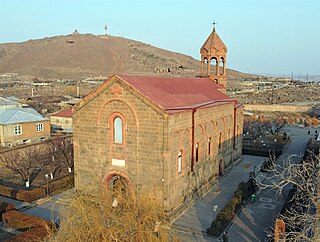
Saint Mesrop Mashtots Church is an Armenian Apostolic church in Oshakan that contains the grave of Mesrop Mashtots, the inventor of the Armenian alphabet. It is one of Armenia's better known churches and a pilgrimage site. Pilgrims visit the church on the Feast of the Holy Translators in October.
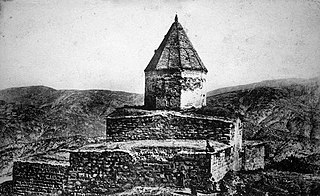
Aparank Monastery or Aparanq, or Holy Cross Aparank, is an Armenian monastery located in modern-day Turkey, Van province near the city of Bahçesaray. It was found within the borders of the historical Armenian province of Mokk.

Diocese of Aragatsotn, is a diocese of the Armenian Apostolic Church covering the Aragatsotn Province of Armenia. The name is derived from the historic Aragatsotn canton of Ayrarat province of Kingdom of Armenia.

Mesrop Mashtots Monastery or St. Gr. Lusavorich Monastery was an Armenian monastery located in Nəsirvaz village of the Nakhchivan Autonomous Republic of Azerbaijan. The monastery was located in the western part of the village.
